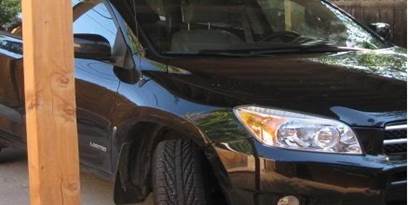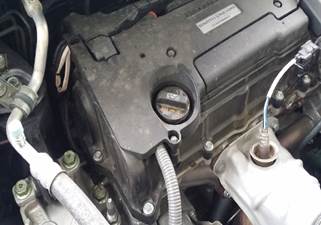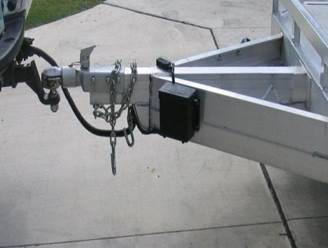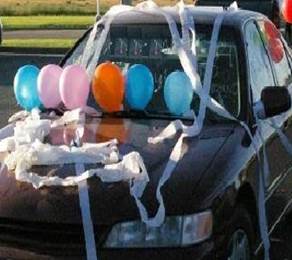(September, 2018)
PART D - COVERAGE FOR DAMAGE TO YOUR AUTO
This section is a serious departure from the
earlier sections, since instead of liability to other injured parties, it deals
with actual damage to the insured’s covered vehicle (including expenses because
of loss of use of the same).
Insuring Agreement
A. Under paragraph A of the
insuring agreement, the Personal Auto Policy agrees to protect “your covered
auto” or a “non-owned auto” against accidental loss. Any payment includes
compensation for loss to auto equipment but does not include the applicable
deductible. If you’re unlucky enough to have more than one covered vehicle
involved in the same collision loss, only a single, highest deductible will count
against any loss payment.
|
Example: Barney and Kloorene
Runarown have two Toyota mini-vans that
are covered by a PAP. The vans aren’t their vehicles of choice, but they also
have four lovely offspring who keep them incredibly busy with their sports
and other activities. It’s fall and the Runarowns often have to split up in order to handle four
kids on four different sports teams. It’s not unusual to have one parent zoom
into their driveway to pick up some little Runarowns,
while the other is zooming out with the others. One day, instead of zooming
in and out of their driveway, they zoomed into each other. While there was
$3,200 in damages to his van and $1,900 to hers, they were glad that only a
single $500 deductible applied to the whole loss.
|
This section clearly
applies only to collision and other than collision losses, but only if the
policy’s declarations page shows a deductible choice to indicate that these
coverages apply. Should a loss involve a non-owned auto, the broadest coverage
written for “your covered auto” applies.
|

|
Example: Your declarations page lists a ’06
Chevy Cavalier with BI, PD and UM/UIM coverage only and a ’12 Explorer with
liability, collision and other than collision deductibles. The Explorer is at
your car dealer to repair some body damage from a not-at-fault collision, and
you are using a rented car. While turning into your company’s parking lot,
you hit a wrought iron fence, causing serious damage to the fence and the
rented vehicle. Instead of just handling the damage you caused to company
property, the PAP responds by acting as if the rented car has the same
coverage as the Explorer. The policy would act in the same manner even if the
rented car replaced the Cavalier. The reasoning is that ‘non-owned”
situations are temporary, and the low level of exposure justifies that the
PAP extends reasonable coverage for these situations without providing
broader coverage.
|
B. “Collision” refers
to your covered auto or your non-owned auto which has either hit or been hit by
another vehicle or some other item. It’s implied that the event has to result
in damage to your car. It also covers the damage to the covered or non-owned
auto when it flips or is otherwise upset.
|
Example: While parking your car at a
supermarket, you slam headfirst into a fully inflated helium balloon that’s
being used to promote their fresh cucumber sale. Besides creating a lot of
laughter, no harm is done to your car or the store’s balloon. Collision? Yes.
A loss under Part D? No, because nothing was damaged or destroyed.
|
410_C076 Insured Unable to
Prove Her Injury Was Result of Rear-End Collision
“Other than collision”
simply refers to those events that aren’t collision. The PAP lists 10 events
that qualify as other than collision losses. If your covered car is damaged by
items falling from the sky, fire, theft, explosion or earthquake, windstorm,
hail or flood, vandalism, rioting, contact with birds and animals, or if glass
has broken, you’ve experienced an other than collision loss. The PAP is
flexible about losses involving glass. If any vehicle glass is broken during a
collision, an insured may choose to have it covered under the collision portion
of the policy.
C. Now let’s move on to
“non-owned” autos. These are private-passenger vehicles (including trailers),
vans and pickup trucks that, while being operated or used by an insured, aren’t
owned by or regularly available to any insured (which includes any “family
member”).
|
Examples:
|

|
|
A PAP is written for a husband and
wife. The wife is late coming home from work, so the husband borrows his
neighbor’s car to take his daughter to a sleep-over. This is an eligible
non-owned situation.
|
|
Your son’s Little League coach has
to stay at the park to prepare the baseball diamond for the next day’s game,
but he promised his team a pizza dinner. You agree to take the kids over to
the restaurant in his mini-van while he uses your Chevy in order to join you
in an hour. This is an eligible non-owned situation.
|
|
You borrow your neighbor’s car to go
to the mall. The car belongs to the neighbor’s daughter, who’s away at
college. They gave you an extra set of keys so that you can use it as needed,
as long as you keep gas in it. This is NOT an eligible non-owned situation.
|
|
Mom has to pick up some groceries
for a dinner party. Dad has the car, so she jumps into her son’s car. It’s an
old “beater” that’s not registered or licensed...the son is going to take
care of that after it’s completely fixed up and painted. This is NOT an
eligible non-owned situation.
|
Related Article: Auto
Dealer Customers Covered Under Their Personal Auto Policies
Note: This definition, while
including pickups or vans, does not include a reference to their gross vehicle
weight such as is made in the definition of “newly acquired auto.”
Another class of vehicle
that’s considered a non-owned auto is a temporary substitute. This refers to an
auto or trailer that takes the place of a covered auto (or trailer) because the
covered vehicle is unavailable while being repaired, replaced or maintained.
The rationale for covering non-owned autos is that these are temporary
situations that don’t typically increase the exposure contemplated by your
premium, so the PAP should be available to provide protection.
|
Example: You’ve taken your car down to
Mac’s Garage for a re-alignment after you hit a city record 14 potholes in
one day. Mac gives you his trusty ’93 Fiero to use until your chariot is
repaired. On the way home, you studiously avoid potholes….until you swerve
out of your lane and sideswipe another car. This is a covered temporary
substitute situation.
|
Related Court Cases:
Rental
Car Fails to Qualify As A Temporary Substitute.
Temporary
Borrowed Car Or Replacement For Inoperable Car?
D. Exclusion 10. that
is found later in this policy excludes coverage for custom equipment. This part
of the policy is all about explaining what custom equipment is. Under the
latest edition of the PAP, custom furnishings and equipment include such items
as carpeting, insulation, furniture or bars, ovens, beds/couches, roof
extensions, murals, paintings, etc.
Custom equipment does not include property in the vehicle that is original
manufacturer equipment or parts and similar property that replaced original
manufacturer equipment or parts. Further, electronic property that is designed
to handle audio signals, video or data does is not custom equipment. (09 18
addition)
Related Article: Personal
Auto Policy Endorsements
Transportation Expenses
A. An insured can
accumulate significant expenses related to the loss of a covered vehicle. The
PAP is sensitive to this likelihood, and it includes some additional coverages.
It will pay up to a maximum of $900 to help cover the cost of
getting replacement transportation. (09 18 change)
1. The PAP will pay up
to $30 a day. This coverage is only provided if the covered
car is unavailable due to a collision or other than collision loss. Of course,
the declarations page must show that the applicable coverage has been selected.
In the midst of this section
that provides physical damage coverage lies liability protection. The PAP also
compensates an insured for legal liability for the loss-of-use expenses for
damage to a non-owned car. This coverage is limited to $30 per
day with no mention of a maximum. Of course, this is a small loss
exposure, so no other limit may be necessary. (09 18 change)
|
Example: Jennifer’s car is having its
brakes replaced. She rents a car from “We-R Not Selling Insurance Auto Rental
Co.” for a day. Unfortunately, upon returning the car the next day, she rams
into one of their carport support beams, smashing the body against the front
tires. The PAP would pay for “We’-R-Not’s” loss of rental income (subject to
$30 daily maximum) for the day it takes them to get the car back into
service.
|

|
|
Example: Jim and his family have only
one car and it broke down while his daughter was trying to return home from
her high school’s football game. Jim borrows his neighbor’s ‘12 Sonata to
pick her up. Unfortunately, just as he turns onto their street with his
daughter (and a dead battery from his own car), Jim has a collision. Since
Jim’s neighbor’s car has to be at his car dealer’s body shop for a few days,
Jim’s PAP will take care of the cost to rent a car.
|
B. The PAP also will cover
additional transportation expenses if an owned or non-owned auto is stolen.
However, coverage won’t begin until 48 hours after the theft. In all other
cases, coverage begins after 24 hours (that a covered vehicle is unavailable
for use). Coverage ends when the covered car is back for the insured’s use or a
settlement has been made. All coverage is subject to any limits and provisions
shown in paragraph A of the coverage. Further, all payments end when the auto
is available for use or the loss has been settled. Payments under this
provision are also subject to the time it should reasonably be expected to
repair or replace the applicable auto.
Exclusions
Part D - Coverage for Damage to Your Auto
will not pay for:
1. Loss to an owned or
non-owned auto that occurs while it is used for hire to transport persons or
goods. This exclusion has been revised to make coverage intent clearer.
It now makes reference to the coverage ineligibility when any insured driver is
actively using any vehicle in conjunction with a transportation network
platform. Active use means providing such use as a driver. The exclusion
applies both while seeking passenger contacts and during transporting
passengers. (09 18 change)
Both the 01 05 and the 09
18 PAP editions maintain an important exception to this exclusion, with a
difference.
a. Coverage is still
permitted for vehicles used in traditional car pools (where the insured gets
gas and maintenance money from car pool riders).
b. An additional exception
is referenced, allowing coverage for a vehicle during its use in charity and
volunteer situations. Protection extends to instances of both ownership and
operation during such instances. (09 18 change)
2. Damage resulting from
your car’s aging, extremely cold weather, mechanical or electrical breakdown,
or road damage.
|

|
Example: It took Pete two hours to
start his car during a typical winter’s morning in North Dakota. After
it starts, he jumps in the car and the engine dies. He has it towed
to Fargo’s best garage and the mechanic tells him that the car is toast.
Pete used a cheap engine oil that broke down due to EXTREME cold, and the
engine wasn’t lubricated. As much as we might feel for Pete, this is not a
covered loss under the PAP.
|
An exception is made for
such damage that is related to the total theft of a covered auto (owned or
non-owned).
|
Example: Pete gets a new car and is
leaving a restaurant to get his car from his parking space when he notices
that a stranger is breaking into his car. The thief sees Pete, quickly
hot-wires the car, and drives out of the lot. The thief is in such a hurry
that she doesn’t bother to avoid a loose sewer cover while escaping. The
police discover the car the next day with the interior stripped of
electronics. The front end, including the tires, is severely damaged.
Normally, the destroyed tires would be excluded, but since it happened during
a theft, Pete’s settlement would include reimbursement for the tire damage.
|
3. There’s no coverage
for any loss caused by radioactive contamination, nuclear weapons, war,
insurrection, rebellion or revolution.
|
Example: Alan Newtron
is coming home from work and he rear-ends a panel truck from a hospital that
just started operating in his area. He is puzzled when, as he gets out to
trade insurance information, the doors of the truck are flung open.
Screaming, the truck’s driver and two passengers jump out and run from the
truck. Alan also wonders why they were wearing protective suits. Alan’s
curiosity is satisfied when he peers into the truck and notices that a new
X-ray machine is laying in the back...cracked into two pieces. Any damage
caused by the ongoing irradiation is excluded from coverage.
|
4. Part D of the PAP
does not cover loss to electronic equipment designed for reproducing, receiving
or transmitting signals (both audio and visual). For instance, the PAP begins
by excluding coverage for equipment such as radios, tape decks, stereos or
compact disc players. Other items that are becoming common auto components are
also barred from coverage such as navigation devices, phones, computers, TVs,
scanners and similar equipment. However, there are some exceptions. There IS
coverage for equipment IF the equipment is permanently installed in your
covered auto or any non-owned auto.
Note: Another issue that
may need to be addressed, although the items that are listed in the PAP is just
illustrative, the fact that it includes obsolete devices and fails to mention
newer devices could still create claim disputes.
5. This exclusion is
for any media that is used with such equipment as well as any accessories used
with equipment that reproduces sound, receives or transmits (audio and/or
visual) signals.
|

|
|
A rearview camera, permanently
mounted, is a newer type of accessory that qualifies for coverage under the
PAP.
|
6. No coverage is available
for vehicles listed on the policy or those that qualify as a non-owned auto
when they are destroyed or taken by military or civil authorities.
|
Example: Marnie’s car is confiscated by the
local police when illegal drugs are found to have been hidden in the vehicle.
This loss is ineligible for coverage under Marnie’s PAP.
|
Of course, an exception is
made for the financial interests of loss payees. It isn’t in the public
interest to deny protection to lenders because of the illegal acts of their
borrowers.
7. There’s no coverage
for a camper body, motor home or trailer owned by an insured, but not listed on
the declarations page. Neither is there any coverage for awnings, cabanas
(lightweight structures with living facilities) and equipment designed to
create additional living facilities including cooking, refrigerating or
plumbing equipment. Coverage for such property should be endorsed to the policy
using PP 03 07–Trailer/Camper Body Coverage (Maximum Limit of Liability). Of
course, in many instances it would make more sense to purchase a special motor
home or RV policy to properly protect rolling homes.
Related Article: Personal
Auto Policy Endorsements
Are there any exceptions?
Yes. This exclusion doesn’t affect coverage for trailers (including their
facilities or equipment) that are NOT owned by an insured.
|

|
Example: Sarah Grizzled was a poor, but
avid, backpacker. While she usually just liked to camp with a tent, a friend
convinced her to borrow his camper trailer for an excursion out West. Sarah
was initially skeptical but, after a week’s use, came to truly enjoy the
trailer. Sarah was as upset as her friend when, while cresting a narrow,
twisting mountain road, a quick maneuver caused the trailer to swing into the
mountainside, obliterating it. This loss would be eligible for coverage under
the PAP.
|
The PAP also provides
coverage for trailers (including their facilities or equipment) that are newly
acquired by the insured and which are reported to the insurer within 14 days.
The intent of the policy is to make sure that all exposures are reported and
rated.
|
Example: A retired couple buys a travel
trailer without reporting it to their insurance company. Two weeks later,
they take off on an extended vacation, a cross-country trip. Just as they’re
entering the third week of travel, the trailer detaches from the hitch while
heading toward Pike’s Peak. The trailer is destroyed. Unfortunately, the
trailer is also uninsured, since it wasn’t reported in time.
|
Of course, coverage would
also apply to such equipment that the insured already owns on the date that the
property is reported and coverage requested by the insured. However, most
companies have their own additional restrictions in order to protect themselves
against insureds who try to save money by requesting coverage while a trailer
is being used (such as the summer) and then removing coverage while the
property is in storage.
8. Any insured,
including a family member, who has a loss involving a non-owned auto will find
him without coverage if he doesn’t believe he has permission to use that auto.
Related Court Case: Insurer
Must Cover Non-Owned Auto Loss
9. Any equipment used to
detect or locate radar or lasers aren’t protected if it is lost or damaged.
10. All custom
equipment (referenced in Part D in Coverage to Your Auto insuring
agreement, Part D) is excluded from coverage. (09 18 addition).
Note: The change is that
examples of custom equipment are removed from reference in the exclusion and
now appears separately under this Coverage Part’s Insuring Agreement.
There has also been a
change to the exception to this exclusion. In the previous edition, the
exclusion did not extend to a covered pickup truck’s cap, cover or bed liner.
The revised exception is more generic and pays for the first $1,500 of a custom
equipment loss. The equipment is covered while in either owned
or non-owned autos. (09 18 Change).
11. This eliminates
coverage for any non-owned auto that is being held or used by any insured while
working at selling, repairing, servicing, storing or parking cars. The
exclusion specifically mentions that it applies even during road
testing and delivery. HOWEVER, this exclusion just applies to vehicles that are
made for use on public highways.
It looks like exclusion 11
bars coverage for any auto-related business.
12. There is no coverage for
any loss to an auto that is related to organized vehicle competitions that take
place within a facility meant for racing. Traditionally this
limitation applied to vehicles in such a facility while practicing, preparing
or competing in races or speed contests. However, the latest edition of
the PAP has been revised. Besides the activities just listed (racing and speed
contests), this exclusion also applies to driver skill training and driver
skill events. In addition, the exclusion applies to those participating in any
of the above instead of being limited to only those competing. (09 18
change)
Of course, your car should
be safe if it’s in the parking lot of a NASCAR track...at least we hope so.
Actually, the change to the PAP is logical to fulfill the policy’s intent to
avoid coverage for race-related exposures; including such times that a vehicle
is at a location as a precursor to a participating in a race.
|
Example: An insured has a mint condition
Yugo that’s been modified for racing. (Hey, we didn’t say it was a smart
insured.) Anyway, the turbo Yugo is sitting in a racetrack garage just prior
to a race when a nervous track visitor knocks over some fuel that splashes
onto some hot equipment, starting a fire. Tragically, the Yugo is consumed.
More tragic, this loss wouldn’t be covered.
|
The PAP definitely distances
itself from covering cars that have anything to do with organized competition.
Persons who have these exposures have to look for special coverage, since ISO
does not fill the coverage gap with any endorsement.
13. This item excludes
any loss to a non-owned auto (including loss of use) rented by the named
insured, resident spouse or family member when any applicable state law or
rental agreement prohibits a rental car company from collecting for any loss or
loss of use. In other words, the PAP won’t provide protection when either state
law or a rental contract provides that coverage must be part of the rental
transaction. Such a legal requirement makes coverage under a PAP unnecessary.
|

|
Example: Karen Sufistakatid
and her fiancée are on vacation and Karen has suggested spending a week
traveling in the bordering western state. Although Karen’s late model car is
covered by a PAP, she prefers to rent a car since she doesn’t want to affect
the mileage use of her leasing agreement. Before renting the car, she asks
her insurance agent if she should get coverage for the rental. The agent
says, “I guess so, but I think your policy covers rentals.” Karen then calls
a local car rental company. A rental clerk says that she can use her auto
policy as coverage but must sign a special agreement to allow her credit card
to be automatically billed for any losses to a rental including a daily
charge for lost car rental income. Karen is relieved when she finds that the
state she is vacationing in requires all rental companies to provide full
coverage for ANY loss to a rental car for only a few dollars a day.
|
14. No loss to a covered
vehicle applies during the period that both of the following apply to the
vehicle:
a. There is a written contract
under which the vehicle is part of a personal vehicle sharing program
b. That vehicle is being
used by a person other than the named insured or a family member (as defined)
of the named insured who is participating in a program referenced in 12.a above.
(09 18 addition)
15. No coverage extends to
claims involving a non-owned vehicle that involves damage, destruction, or loss
of use of that vehicle when such claims are related to the use of the vehicle
under a personal vehicle sharing program. This exclusion applies when both
of the following apply:
· A non-owned vehicle is
used by the named insured or a family member (as defined) of the named insured
· No recovery can be
demanded from the named insured or family member due to the parameters of the
sharing program’s written agreement or due to state law. (09 18 addition)
16. This exclusion is also
new. It bars coverage for loss involving flying vehicles, whether flight is
their sole capability or is among their features. (09 18 addition)
Limit of Liability
A. The PAP does have
restrictions on the total amount of coverage available for a loss to a covered
vehicle.
1. Paragraph A. of Part D -
Coverage for Damage to Your Auto - states that the policy is obligated to pay
the actual cash value of the lost (stolen or damaged [including total losses])
property, or
2. To pay what’s needed to
repair or replace the property,
whichever is the LEAST EXPENSIVE option.
This provision includes the option of settling a loss by using property of like
kind and quality.
This section also explains that the maximum
available for the loss of:
· A non-owned trailer is
$1,500;
· Equipment that merely
reproduces sound (such as a CD player) which is installed in a place other than
where intended by the vehicle manufacturer is
$1,000. Loss to accessories of that equipment is subject to the same $1,000.
· Property installed on
either an owned auto (that qualifies as a covered auto) or a non-owned auto
which meets the definition of custom
equipment is $1,500 (09 18 addition)
B. Any settlement
includes an adjustment for a vehicle’s decreasing market value (depreciation)
and physical condition when determining its actual cash value after a total
loss. Finally, under paragraph C, if the repair or replacement of a covered vehicle
results in an insured being better off than before the loss, the PAP won’t pay
the value of the improvement.
C. While not defined,
the words “of like kind and quality” can have a significant impact on
settlements. As the cost of vehicles and vehicle parts continues to increase,
insurers face more pressures to find options that indemnify their insureds
while not “breaking the bank.” As it is with homeowners insurance, the need to
repair damaged property often puts auto insurers in the position of having to
actually improve an insured’s position after a loss. Use of the terms “like
kind and quality,” allows carriers options other than the problematic use of
new parts to make repairs and then attempt to adjust the value of the
settlement.
Payment of Loss
This provision discusses a company’s options
in making a settlement on a loss to a covered vehicle. The settlement may be in
the form of a cash payment, a repaired vehicle or a replacement vehicle. The
insurer has the option to return any stolen property to the named insured or to
the latest address shown on the declarations page. If any property is returned,
the insurer must pay for doing so, and only after any damages have been
repaired. Further, should the company exercise the right to keep the property; it
has to be at a price that’s acceptable to both parties. Finally, if the
settlement is made in cash, the total has to include any sales tax.
No Benefit to Bailee
A carrier for hire or a bailee for hire is
not permitted to benefit from the PAP.
The Personal Auto Policy has a tradition of
trying to identify precisely the parties to the insurance contract. One of its
intentions is to perform its contractual obligations to the named insured and
other parties defined in the definitions, insuring agreements and other policy
provisions. To do otherwise would be to open the policy up to parties who
haven’t been rated or underwritten for coverage and for more exposures than
contemplated. Other parties may benefit unintentionally from the policy without
this provision. Such persons or organizations can’t piggyback their obligations
to the PAP.
Related Court Case: "Car
Wash Assumes Liability When Customer Relinquishes Vehicle For Service"
Other Sources of Recovery
This provision is to make sure that any
payment under Part D of the Personal Auto Policy takes other sources of loss
payment into account. If other insurance policies, provisions or sources of
recovery apply to a physical damage loss, the policy will only pay its
proportion of the total available coverage. But the proportional payment is
only for owned autos. If other sources of payment exist for a loss involving a
non-owned auto, Part D of the PAP responds on an excess basis. It is excess
over everyother available source of
payment, including the policy of the owner of the car.
The provision to pay its proportionate share
on owned auto losses effectively assures that the policy won’t pay more than
the limits of liability listed on the declarations page. Of course, it has no
other way to control the amount paid by other sources.
Related Court Case: Parties
Dispute Applying “Other Insurance”
Appraisal
This system works quite similarly to an
arbitration clause, except that the only point of dispute is the amount of
payment, rather than the amount of payment and/or whether payment is due. This
provision may be invoked when the company and the insured don’t agree on the
amount of the loss. Each party must select its own qualified (competent and
impartial) appraiser. The two appraisers then select an umpire. The appraisers
then submit their opinion of the actual cash value and the amount of the loss.
If they don’t reach agreement, they submit this information to the umpire. An
agreement by any two persons is binding on both parties.
The company and the insured have to pay for
the expenses of their own appraiser, as well as equally share the expenses of
the umpire.
Note: No other insurer rights
are affected by their agreeing to an appraisal. For instance, if another party
has some responsibility for the loss, the insurer, after paying the appraised
amount of loss, may still subrogate the claim.